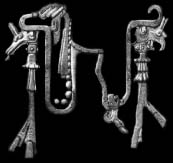Shamanism
"this is rock medicine, the talking tree, the singing water"
Shamanism"this is rock medicine, the talking tree, the singing water" |
 |
|
|
This FAQ contains a general overview on Shamanism. It should be read by anyone interested in understanding what is meant by Shamanism and what differentiates Shamanism from other forms of ecstatic experience. |
|
|
This FAQ contains the charter for soc.religion.shamanism, details of submissions policies, and frequently asked questions culled from the articles that have appeared in the newsgroup. |
|
Shamanic terms and concepts
Find public discussions about shamanism in | |
| "Shamanic ecstasy is the real "Old Time Religion," of which modern churches are but pallid evocations. Shamanic, visionary ecstasy, the mysterium tremendum, the unio mystica, the eternally delightful experience of the universe as energy, is a sine qua non of religion, it is what religion is for! There is no need for faith, it is the ecstatic experience itself that gives one faith in the intrinsic unity and integrity of the universe, in ourselves as integral parts of the whole; that reveals to us the sublime majesty of our universe, and the fluctuant, scintillant, alchemical miracle that is quotidian consciousness. Any religion that requires faith and gives none, that defends against religious experiences, that promulgates the bizarre superstition that humankind is in some way separate, divorced from the rest of creation, that heals not the gaping wound between Body and Soul, but would tear them asunder... is no religion at all!" Jonathan Ott |
 |
South American Ayahuasca Practice
This brew, commonly called yage, or yaje, in Colombia, ayahuasca (Inca 'vine of the dead'*) in Ecuador and Peru, and caapi in Brazil, is prepared from segments of a species of the vine Banisteriopsis, a genus belonging to the Malpighiaceae. —Michael Harner*Inca "vine of the dead, vine of the souls," aya means in Quechua "spirit," "ancestor," "dead person," while huasca means "vine," "rope").
|
| Common Themes in South American Indian Yage Experiences | ||
|
Michael J. Harner's 1968 paper The Sound of Rushing Water chronicles the Ayahuasca magic of Jivaro Indians in Ecuadorian Amazonia. | ||
|
The basic notion exists that ayahuasca teaches "magic melodies" known as icaros. | ||
|
In my first experience with ayahuasca in the Amazon jungle, plants of the jungle did appear before me and speak, just as the shamans report happens with them. The problem was that I did not understand their language! | ||
|
Gracie & Zarkov take Ayahuasca and visit with an Indo European Plant Teacher. | ||
|
A description by a Peruvian youth who was captured by Amahuaca Indians of the preparation of ayahuasca by the tribal medicine man.
| ||
| Ayahuasca adventures in the Peruvian Amazon | ||
| ||
|



"Shamanism and similar areas of research have gained in significance because they postulate new ideas about mind and spirit. They speak of things like vastly expanding the realm of consciousness ... the belief, the knowledge, and even the experience that our physical world of the senses is a mere illusion, a world of shadows, and that the three-dimensional tool we call our body serves only as a container or dwelling place for Something infinitely greater and more comprehensive than that body and which constitutes the matrix of the real life."
Holger Kalweit, Dreamtime and Inner Space


 Technological Shamanism
Technological Shamanism
"Remember the shaman when he used to say
Man is the dream of the dolphin" Enigma2
